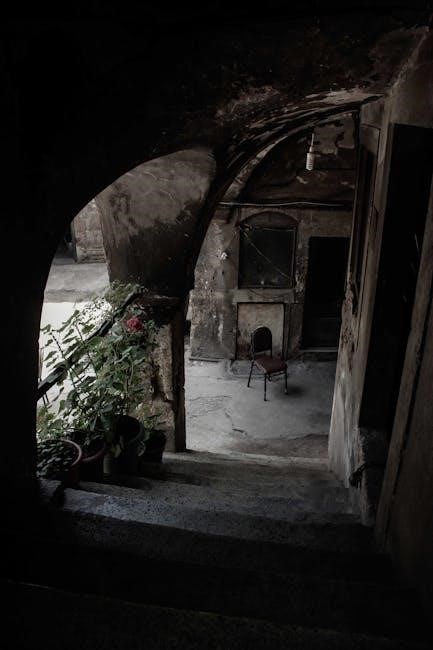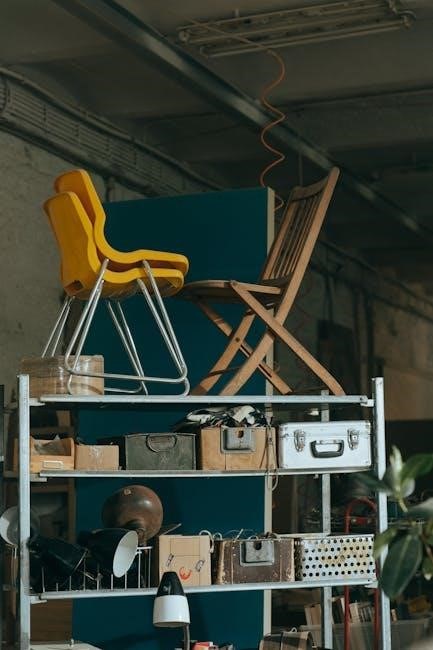Identifying vintage antique chairs requires a keen eye for design, materials, and historical context. This guide helps enthusiasts uncover the stories behind each piece, bridging past and present.
1;1 Understanding the Basics of Antique and Vintage Chairs
Antique chairs are typically over 100 years old, while vintage chairs are younger but still considered classic. Both reflect historical design trends and craftsmanship. Understanding their origins and styles is essential for identification. Key elements include construction materials, such as wood, metal, or upholstery, and design features like carvings, legs, and backrest shapes. Historical context, like the Victorian or Art Deco periods, also plays a crucial role in determining a chair’s age and authenticity. Recognizing these basics helps enthusiasts appreciate the chair’s value and significance.
1.2 Importance of Proper Identification for Collectors and Enthusiasts
Proper identification of vintage and antique chairs is crucial for collectors and enthusiasts, as it determines authenticity, historical significance, and market value. Accurate identification ensures pieces are appraised correctly, avoiding misattribution or undervaluation. It also helps enthusiasts understand the chair’s origins, design influences, and cultural context, enhancing their appreciation and connection to the piece. Correct identification supports ethical collecting practices and preserves the chair’s historical integrity, making it a valuable and meaningful addition to any collection.

Key Characteristics for Identifying Vintage Chairs
Key characteristics include design elements like shape, proportions, and ornamentation, as well as materials, construction quality, and maker’s marks, which help determine the chair’s era and authenticity.
2.1 Examining the Chair’s Design and Time Period
Examining the chair’s design and time period involves analyzing its style, proportions, and decorative elements. For instance, Victorian chairs often feature intricate carvings and upholstery, while mid-century modern designs emphasize simplicity and clean lines. Understanding the historical context of the chair’s design helps determine its era and potential origins. By identifying distinctive features such as curved legs, straight backs, or ornate details, enthusiasts can narrow down the chair’s time period and connect it to specific design movements or cultural influences.
2.2 Recognizing Materials and Construction Techniques
Identifying materials and construction techniques is crucial for authenticating vintage chairs. Solid woods like oak, maple, or mahogany were commonly used, while mid-century pieces often feature laminated wood. Examine joints—dovetail, mortise-and-tenon, or pegged constructions indicate craftsmanship and era. Upholstery materials, such as horsehair or velvet, can also hint at the chair’s age. Look for hand-carved details or machine-cut elements, as these reveal the chair’s historical context and manufacturing methods, aiding in determining its authenticity and period.
2.3 Identifying Maker’s Marks, Labels, and Signatures
Makers’ marks, labels, and signatures are essential for verifying the authenticity of vintage chairs. These marks, often found on the underside or inside frames, may include the maker’s name, initials, or production dates. Inspect carefully, as they can be faint or worn over time. Signatures and labels can help trace the chair’s origins and confirm its historical significance. Use magnifying tools for clearer inspection, and research known maker’s marks to match your findings. These details are vital for accurate identification and valuation.

Researching the History of the Chair
Uncover the chair’s origins by investigating its provenance, historical context, and cultural significance. Use online resources, antique guides, and expert insights to verify its authenticity and heritage.
3.1 Investigating the Chair’s Provenance and Origins
Tracing a chair’s provenance involves uncovering its historical journey, including past owners and origins. Examine documentation, receipts, or family records linked to the piece. Look for maker’s marks or signatures that tie it to a specific craftsman or region. Historical styles and materials can also indicate its origins. Consulting experts or historical archives can validate its authenticity. Understanding the chair’s backstory enhances its value and connects it to broader cultural or historical contexts, making it a meaningful addition to any collection.
3.2 Using Online Resources and Antique Guides for Verification
Leverage online databases, auction sites, and antique forums to verify a chair’s authenticity. Use detailed photos and descriptions to cross-reference with known styles and eras. Antique guides provide invaluable insights into historical designs, materials, and craftsmanship. Websites specializing in vintage furniture often feature searchable databases of chair styles, making identification more accessible. By combining digital tools with printed resources, enthusiasts can confidently authenticate and date their finds, ensuring accuracy and uncovering the chair’s true historical significance.

Evaluating the Chair’s Condition and Authenticity
Evaluate the chair’s condition by inspecting for wear, tear, and restoration. Authenticity is confirmed by patina, historical markers, and consistency with its claimed era and craftsmanship.
4.1 Assessing Wear, Tear, and Restoration Work
When evaluating a vintage chair, inspect for signs of wear and tear, such as scratches, dents, or fading. Check joints and frames for stability and signs of repair. Restoration work, like reupholstery or refinishing, can impact authenticity and value. Look for consistent aging across surfaces; uneven wear may indicate later alterations. Minor flaws can enhance a chair’s character, but significant damage may reduce its worth. Use magnification to spot fillers or overpainting. Consult experts if restoration work is unclear or extensive.
4.2 Determining the Chair’s Age Through Patina and Details
Patina, the natural aging process, offers clues about a chair’s age. Examine the finish for a soft, even sheen developed over decades. Inspect hardware and joints for oxidation or corrosion, indicating authenticity. Carvings, upholstery nails, and joinery techniques can date a piece. Look for period-specific details, such as Victorian-era embellishments or Art Deco motifs. Verify materials common to the era, like solid woods or hand-forged metals. These elements collectively help pinpoint the chair’s origins and historical context, ensuring accurate age determination.
Understanding Common Styles and Periods
Recognizing styles like Victorian, Edwardian, and Georgian, or Mid-Century Modern, helps date chairs. Each era has distinct designs, materials, and craftsmanship, aiding identification and historical context.
5.1 Victorian, Edwardian, and Georgian chair styles
Victorian chairs (1837–1901) are ornate, with dark woods, upholstery, and intricate carvings. Edwardian styles (1901–1910) are lighter, blending past influences. Georgian chairs (1714–1830) feature refined designs, often with classical motifs, reflecting elegance and craftsmanship. Each era’s unique aesthetic aids in identifying pieces, helping enthusiasts trace their origins and historical significance.
5.2 Mid-Century Modern and Art Deco Influences
Mid-Century Modern chairs (1930s–1960s) feature clean lines, minimalism, and functional designs, often in teak or walnut with upholstered seats. Art Deco chairs (1920s–1940s) are ornate, with geometric patterns, metallic accents, and luxurious materials like chrome and velvet. Both styles reflect their eras’ cultural shifts, with Mid-Century emphasizing simplicity and Art Deco celebrating opulence. These designs are distinct from earlier periods, aiding enthusiasts in identifying and dating chairs from these influential movements.
Valuation and Appraisal Tips
Valuation depends on factors like rarity, condition, and provenance. Consulting experts and researching market trends helps determine accurate value for vintage and antique chairs.
6.1 Factors Affecting the Value of Antique Chairs
The value of antique chairs is influenced by several key factors, including rarity, condition, and provenance. Chairs with unique designs or historical significance often command higher prices. The materials used, such as mahogany or oak, and the craftsmanship quality also play a significant role. Additionally, market demand and the presence of maker’s marks can elevate value. Chairs in excellent condition with minimal restoration are typically more valuable than those with extensive wear or repairs. Understanding these factors helps collectors and enthusiasts make informed decisions.
6.2 Working with Experts for Accurate Appraisals
Consulting professionals, such as appraisers or antique dealers, is essential for obtaining accurate valuations of vintage chairs. Experts possess in-depth knowledge of historical contexts, materials, and market trends, ensuring reliable assessments. Their expertise helps identify rare pieces, detect authenticity, and uncover hidden details. Collaborating with specialists not only provides a precise monetary value but also enhances understanding of the chair’s historical significance. This partnership is invaluable for collectors seeking to make informed decisions about their pieces, ensuring both financial and historical accuracy in appraisals.
Restoration and Preservation Best Practices
Restoring vintage chairs requires balancing preservation and functionality. Careful cleaning, minimal interference with original materials, and professional expertise help maintain historical integrity while ensuring longevity and value retention.
7.1 DIY vs. Professional Restoration: Pros and Cons
DIY restoration can be cost-effective and rewarding but risks damaging historical value if improper techniques or materials are used. Professional restoration ensures expertise and preservation of authenticity, though it can be expensive. Weighing these factors is crucial for maintaining the chair’s integrity and value. DIY is suitable for minor repairs, while significant work should be left to professionals to avoid compromising the piece’s historical significance and monetary worth.
7.2 Maintaining the Chair’s Integrity and Historical Value
Maintaining a vintage chair’s integrity involves preserving its original materials and craftsmanship. Avoid using harsh chemicals or modern finishes that could alter its historical character. Store the chair in a stable environment, away from direct sunlight and moisture. Document its provenance and any restoration work to retain its value. Patina, the natural aging process, should be preserved as it adds authenticity. Regular, gentle cleaning and careful handling ensure the chair remains a cherished piece of history for future generations.
Mastering vintage chair identification is a rewarding journey, celebrating craftsmanship and history. With patience and knowledge, enthusiasts can uncover hidden gems, preserving timeless elegance for future generations.
8.1 Final Tips for Successful Vintage Chair Identification

Mastery of vintage chair identification requires patience and dedication. Start with thorough research, examining markings, materials, and historical context. Consider the chair’s provenance and consult experts when unsure. Be cautious of reproductions and restorations, as they can affect value. Practice regularly to refine your skills, and stay updated on market trends. By combining knowledge with a keen eye, you’ll confidently identify and appreciate vintage chairs, unlocking their unique stories and significance.
8.2 Encouraging Further Exploration and Learning
Embrace the journey of learning about vintage chairs by exploring various styles, eras, and craftsmanship. Consult detailed guides, join collector communities, and seek expert insights to deepen your knowledge. Each chair holds a unique story, and understanding its history enriches your appreciation. Stay curious, attend workshops, and visit exhibitions to expand your expertise. Remember, every discovery is a step toward becoming a skilled enthusiast, keeping the passion for vintage furniture alive and thriving.



About the author